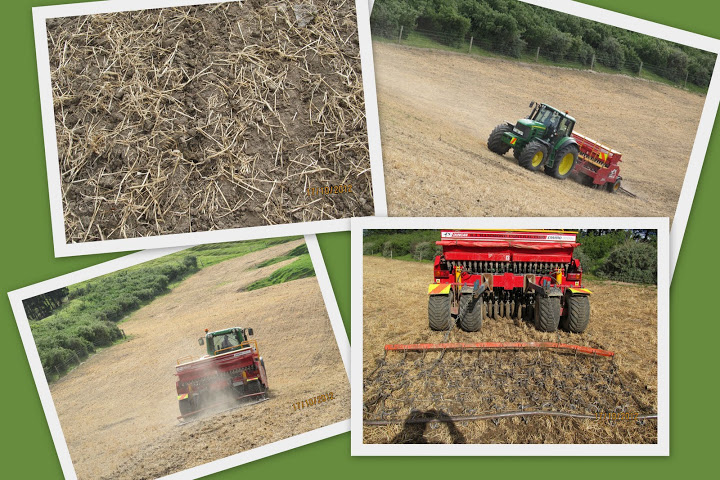North Face was direct drilled on the 17th October in perfect sowing conditions. You can see in the photos below the slight dust coming off the back of the drill indicates that the soil tilth is perfect for maintaining seed to soil contact through the use of the chain harrows behind the drill.
Maintaining good soil structure and the presence of small soil aggregates (fine tilth) is so important when direct drilling, to allow the surface area of the seed to be in close contact with the soil, thus initiating the seed germination processes. The aim of good seed bed preparation, and the key to successful seedling establishment, should be the same for direct drilling as for conventionally worked paddocks. The soil moisture had been well preserved from the fallow period, and with soil temperatures rising the future establishment of this paddock with the Bonavaree mix is set to be outstanding.
The sowing rate for the Bonavaree mix is as follows: 9 kg/ha Lucerne, 15 kg/ha Prairie Grass and 1 kg/ha Plantain.
Sowing depth is closely monitored at sowing, with the depth dictated by the Lucerne component of the seed mix. On average the maximum sowing depth is 10 mm. You could potentially drill slightly shallower in worked ground, providing seed is covered adequately (by harrows), and the soil is firm (rolled post sowing).
Doug says the establishment of the Lucerne in the paddock has been slow on top of the soil, but underneath huge things are happening which will set the plant up for a strong, productive future. From sowing to first flowering the Lucerne plant’s grow roots on average 13 mm per day according to Derrick Moot. It is no wonder Lucerne is able to access sub soil moisture and persist with green and palatable plant material well into the soil moisture deficits experienced every summer in Marlborough.
- The average pasture height was approximately 4 cm for the Lucerne and 6 cm for the Prairie grass and Plantain.
- Visible soil moisture looks to be adequate at the soil surface down to 15 cm.
Fraser keeps a close eye on newly sown pasture by taking a pasture walk every 3 days to ensure that there are no pest or weed problems that need to be controlled. Good seedling establishment is essential to produce a permanent pasture that is productive, performs and persists.
Pasture renovation is an expensive exercise so you need to maximise your investment by carefully observing your newly sown paddock to identify and remedy any issues that crop up quickly before they negatively impact your seedling numbers and their establishment. There was some slug activity noted on my last visit, but was minimal. There appeared to be no springtails present. Some of the Lucerne and Prairie Grass plants were being cut off just below the surface of the soil and left on the surface. Fraser was in the stages of investigating the cause of this damage, at that stage it was not a large concern as it was not affecting large numbers of plants. However, pest problems can quickly escalate and cause major damage to emerging seedlings, therefore Fraser was going to get the local Sales Agronomist to come and have a look.
Weeds have been controlled adequately by the break crop, pre-fallow spray and fallow period. However there were a few plants of mallow that looked to have been knocked back by the spray, but also looked to be in the first stages of recovery. Fraser will continue to monitor this and any thistles, and will spot spray for thistles if necessary.
The plans for this paddock are:
- If it rains, then the paddock will receive a light graze in late December/early January, and then be shut up to set seed.
- If it doesn’t rain the paddock will be shut up till February/March to allow the pasture species to set seed, with no grazing till post seed set.
Key Bonavaree messages:
Carefully monitor newly sown pastures, at least every 3 days, for pests and weed problems. Get onto it early if it looks like they’ll be problematic to seedling establishment to maximise your investment.

